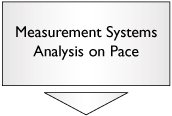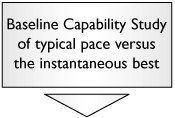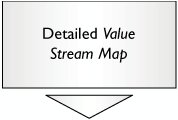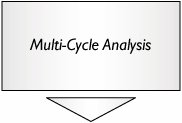E. Pace of Process Too Slow Overview Sometimes, even though the process is up, it just isn't cycling fast enough to generate entities to meet downstream demand. Pace is the speed of the process when it is up and running doing VA work, which can be a confusing concept for some. Pace only looks at the true VA work that is considered Uptime in the % Uptime calculation. This is not the average process rate that is traditionally captured. For a detailed explanation of pace, refer to "Overall Equipment Effectiveness (OEE)" in Chapter 7, "Tools." Look to make improvements in pace only after other categories of NVA work have been improved. Examples Applicable to all industries is that the hands-on "touch time" in a process is too slow. Industrial. Vessel (reaction) times too long, assembly time reduction Healthcare. Procedure time reduction Service/Transactional. In the transportation industry, the actual transportation time and order processing time at a single step
Measuring Performance Measures of Pace of a process are usually process-specific, but are generally written in the form of number of entities per unit time. For example: Kg product/hr Patients/hr Widgets/hr Invoices (or orders)/hr
Similarly, they can be written as an average time to generate or process an entity: The data needs to be captured only when the process is running and should not take into account the average slowing of pace due to process stoppages, downtimes, and so forth. Those elements should be accounted for in the % Uptime metric in OEE. If the concern is more one of Uptime, proceed to Section D in this chapter instead. Tool Approach First we must get an understanding of the current performance with respect to pace. |  | Pace is always a little tricky to determine, so a quick MSA is always worthwhile. Focus should just be on measuring validitya sound operational definition and a consistent measure of pace while the process is doing VA work versus a detailed investigation of Gage R&R. See also the tool detail for OEE in "Overall Equipment Effectiveness" and "MSAValidity" in Chapter 7. | |  | Pace capability is measured as a percentage versus the best the process has ever done (see the tool detail for OEE in Chapter 7). The data should be captured over a period of typically one week to one month (depending on process drumbeat) to get a reasonable estimate of average pace. |
The slow pace could be either due to individual steps in the process not cycling quickly enough; or it could be that all the individual steps cycle quickly enough, but something gets lost in the gaps between the process steps. The tools used in the following roadmap aim to understand which case it is |  | Construct a rigorous Value Stream Map including all the detailed steps for the Primary Entity as it progresses through the process. At this point, don't map the substeps of any VA stepthat mapping will come later. | |  | Apply a Multi-Cycle Analysis to the VSM to flesh out where the time is being spent along with an indication of variation in times. Usually it is the variability in step times that causes the problems. | |  | A Load Chart for the process will show Takt Time versus Cycle Time. For more details see "TimeTakt Time," "TimeIndividual Step Cycle Time," and "TimeGlobal Process Cycle Time" in Chapter 7. This will highlight individual process steps that aren't cycling quickly enough to meet the pace of demand; or it will show that all steps are meeting the pace of demand, but the process as a whole is failing somehow despite this. |
No matter what the Load Chart tells us, at this point it is always useful to use the Value Stream Map to identify NVA activities. The Team should spend time brainstorming action ideas to eliminate NVA activity in the process, which will in turn increase the pace. The Load Chart will lead us to two possible options: |  | If each individual step along the process is able to perform at a rate fast enough to keep up with the pace of downstream demand, go to Section H in this chapter to determine if either The linkage inside the process is failing. The delivery to the downstream Customer is failing. Supply from the upstream supplier is failing.
| |  | If, for some steps, the Cycle Time is greater than the Takt Time (the process steps cannot keep up with the pace of demand), then determine if these truly are VA activities. If not, work to eliminate them. If there are VA steps in the process that are too slow, identify the bottlenecks and proceed to the roadmap outlined in "1: A Single Process Step Does Not Meet Takt" in Chapter 4. |
|






